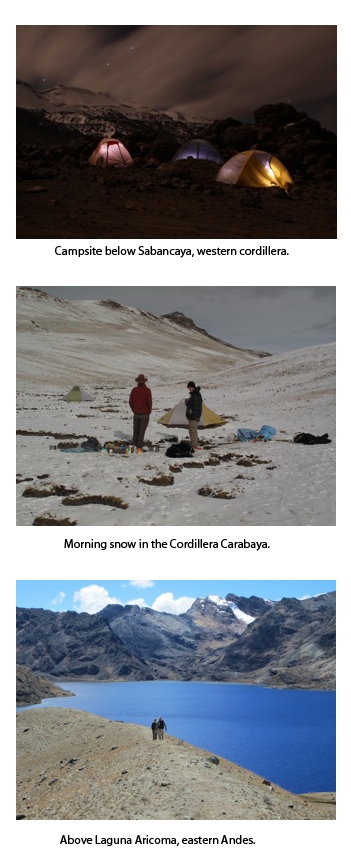Investigating Patterns of Late Pleistocene Glaciation in the Tropical Andes
Tropical Andes
Investigating Patterns of Late Pleistocene Glaciation in the Tropical Andes
Gordon Bromley, Kurt Rademaker, Matthew Hegland
June 15 – July 29, 2011
The primary objective of our project is to use glacial geology to reconstruct both the timing and magnitude of past climate events in the Andes of Peru. This record, ultimately, will span the last glacial maximum, the late-glacial period, and the current Holocene interglacial, and will help us address questions relating to the role of the tropics in climate change. Our approach combines geomorphic mapping with cosmogenic surface-exposure dating (both 3He and 10Be methods) and radiocarbon dating. Moreover, to assess how different tropical regions responded to global forcing, we’re employing this methodology at sites in both the wet and arid Andes.
Gordon completed his PhD at UMaine in 2010 and is now a postdoctoral fellow at Lamont-Doherty Earth Observatory.
Kurt is in the final stages of his PhD at Maine, where he’s focusing on the peopling of the high Andes after the last ice age.
Matt is an undergraduate at Pacific Lutheran University, WA. We’ve been working on this project with his advisor, Claire Todd, since 2006 and so his participation in this season’s work will form part of his dissertation.
This 2011 season saw our small field group – Gordon, Kurt, and Matt – visit the eastern, wetter end of our transect. Laguna Aricoma and Minas Tira both lie in the Cordillera Carabaya, overlooking the Amazon Basin and prone to tempestuous weather even during the dry season. The region is also difficult to access due to local bureaucracy – something we could not navigate successfully without Kurt’s superior Spanish and diplomacy skills. In all, we spent about five weeks exploring this rugged yet populous landscape, identifying and mapping glacial deposits and collecting a large number of boulder samples for surface-exposure dating. At Aricoma, we were fortunate enough to extract a number of sediment cores from moraine-dammed bogs, which should enable us to augment the cosmogenic chronology with radiocarbon data. There’s also a possibility that the faunal record preserved in these cores will provide palaeoecologic data, though it’s early days yet. During our time in the Cordillera Carabaya, the weather turned from typical sunshine and frosty nights to a more wintery mix: high winds, building cloud, and snow. Apparently, this sort of weather is common on the tail end of a La Niña event, such as this year. Whatever the reason, sampling boulders in driving sleet was less than desirable.
Once work was completed in the east, our team headed west towards the desert of Arequipa, the stormy weather hot on our tails. We spent a few days on Nevado Ampato, the statuesque, ice-capped volcano from which the Inca Ice Maiden was plucked in the 1990s, and a short time sampling lavas near Coropuna for cosmogenic calibration work. By the end of the trip, we’d put over 2000 km on the odometer and collected more than one hundred rock samples for analysis. It was, by far, our most successful season yet. Next year, in June-July 2012, we will continue this field work, focusing on Nevado Coropuna in the dry western cordillera.



